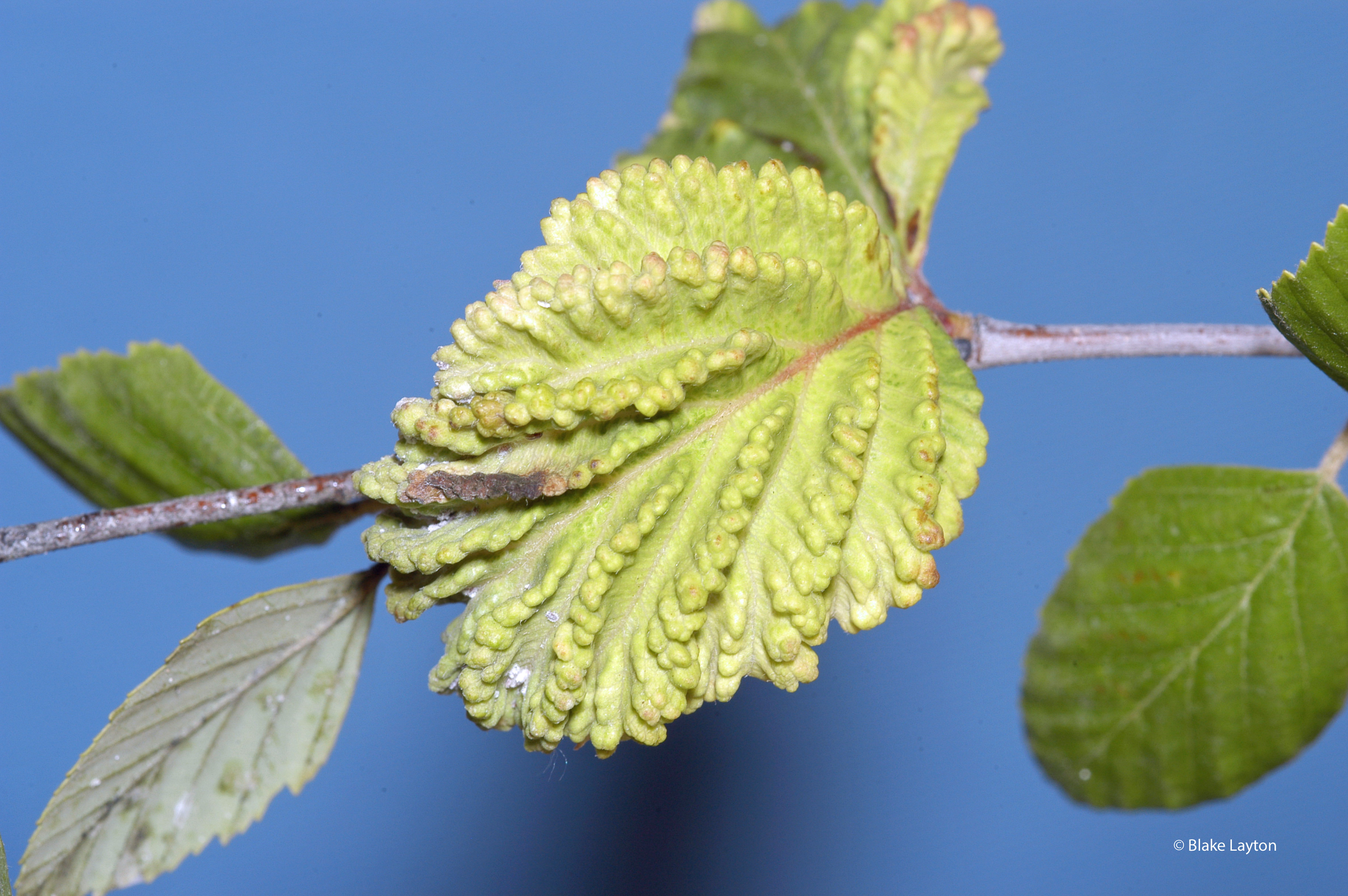Spiny Witch Hazel Gall Aphid, Vol. 10, No. 07
Hamamelistes spinosus
Order: Hemiptera
Family: Aphididae
 “Many of the leaves on our river birch are puckered and red-colored, and the crevices on the undersides are filled with fuzzy white stuff. What is this?”
“Many of the leaves on our river birch are puckered and red-colored, and the crevices on the undersides are filled with fuzzy white stuff. What is this?”
Spiny witch hazel gall aphids are also known as river birch aphids because they spend different generations of their exceptionally complex lives on each of these plants. On river birch, affected leaves are enlarged and distorted, have a distinctive, deeply wrinkled surface, and turn yellow or red. They are quite striking and conspicuous. Heavily infested plants may have accumulations of honeydew and sooty mold, and leaves may be sprinkled with fluffy white material, but serious injury is uncommon. The aphids develop on the undersides of the leaves in gall-like pockets filled with aphids and the white cottony material they produce.
Spiny Witch-hazel gall aphids have an exceptionally complicated life cycle, completing some generations on witch-hazel and others on river birch. There is only a narrow window of time when they can cause leaf galls on the river birch because they must begin feeding on young leaf buds and small expanding leaves to cause them to develop that distinctive leaf puckering. On witch hazel, they cause young flower buds to develop into spiny, hollow, galls. Cut one of these spiny galls open at the right time of year and it will be filled with small aphids. But their host-to-host life cycle is even more complex than this.
These aphids do not simply alternate from river birch to witch hazel and back every year. Instead, it takes two years and several generations to complete a full cycle: 1} Nymphs hatch on witch hazel in spring and cause spiny galls with a second generation of aphids inside. 2} Adults from these galls fly to river birch in summer and give birth to small scale-like aphids that do not cause galls. 3} These scale-like aphids overwinter, crawl onto river birch leaf buds in spring and give birth to young aphids that feed on developing leaves and cause the corrugated leaf galls. 4} Mature aphids from these river birch leaf galls fly back to witch hazel and produce a generation of wingless female and male aphids. 5} Females of this generation lay eggs on the witch hazel bark that will hatch the next year to produce more spiny galls on witch hazel. *
Control: Doing nothing is usually the best way to deal with this pest. Infestations are usually rather light, and by the time the leaves are distorted it is too late to treat anyway. Affected leaves usually turn brown and drop from the tree by mid-summer. Populations vary greatly from year to year, making it difficult to predict the need for preventive treatment.
If river birches are in a sensitive site, such as over a patio where honeydew will cause problems and trees have a history of severe infestations, you can try preventive treatment with a soil-applied systemic insecticide like imidacloprid (Bonide, Ferti-Lome, BioAdvanced, Monterey and others). Apply treatments early in the spring before bud break or in early fall.
Cabbage root aphid is another aphid with an alternating host life cycle, spending some generations underground on the roots of cabbage and other brassica and others inside galls on the leaf petioles of cottonwood trees.
* Life cycle information is from North Carolina Extension fact sheet: Spiny Witch Hazel Gall Aphid, by Jim Baker.
Blake Layton, Extension Entomology Specialist, Mississippi State University Extension Service.
The information given here is for educational purposes only. Always read and follow current label directions. Specific commercial products are mentioned as examples only and reference to specific products or trade names is made with the understanding that no discrimination is intended to other products that may also be suitable and appropriately labeled.
Bug’s Eye View is now on Facebook. Join the Bug's Eye View Facebook group here.

